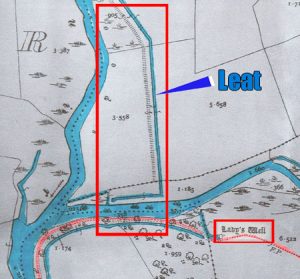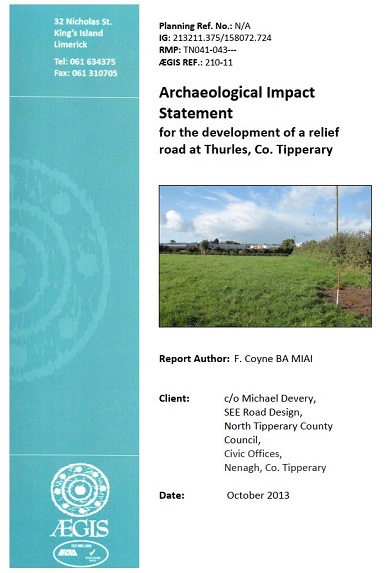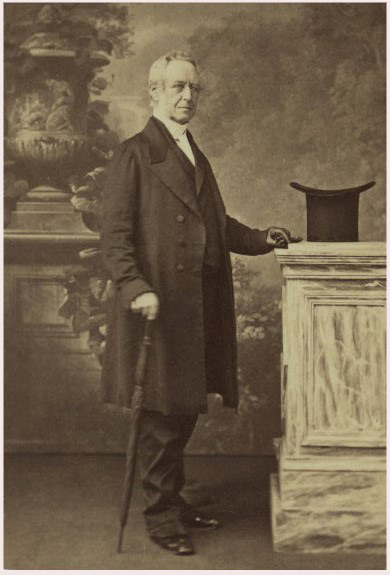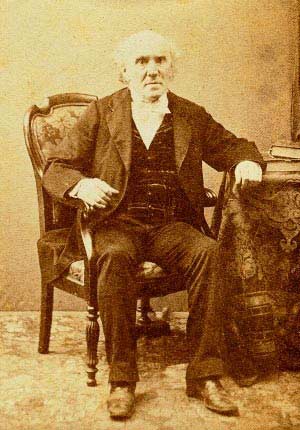Brief research was undertaken by Thurles.Info on the Thurles Knaggs family, following a request by one Ms Charlotte L. Roberts on the Ireland Reaching Out website.
“Things I Remember About My Father and Mother” was a published document written by Ms Charlotte L. Roberts, whose mother was Charlotte Knaggs-Roberts, latter originally from Thurles, in Co. Tipperary.
Charlotte L. Roberts writes fondly about her mother:-
“We walked to church and mother always went except when she had a small baby or someone was ill.
Mother loved music but had never had an opportunity to learn to play. She sometimes played on a Jew’s Harp. Will Atkins, a brother-in-law, directed the church choir at the First Methodist Church. She sang in the choir whenever possible. Sunday evenings she could go because my father would stay home with Olive and me. He would hold me on his lap and sing many hymns – usually gospel hymns.Mother was a very good cook and we always had plenty of good food. She made pickles of the little cucumbers; mustard pickle, red cabbage pickle which was kept in a big crock down cellar; string bean pickles and many kinds of jelly. She also made her own bread and pies and cakes. We had many family picnics, usually at the Trout Ponds.
Mother was always patient with her children. She was born in Thurles, Ireland. Her father and mother were staunch Protestants. There were, Jane, Annie, Sarah, and Charlotte and several sons: Tom, Jim, George, and I think, one other. There was an Anne Jane, two with the name Hannah, [one died as a baby], Elizabeth, Robert, and Benjamin.
They came to America in 1864 and stayed in New York City for a few years. At Duane Street, Methodist Church they met many young people. My mother married John Oliver Roberts. They lived in Ohio for a time where my father bought butter and eggs and shipped them to New York. Later he came to Smithboro and finally to Newark Valley (New York) where they spent the rest of their lives”.
Charlotte L. Roberts writes also about her father John Oliver Roberts:-
John Oliver Roberts 1848 was from Middleton. Co. Cork, was the son of John Oliver Roberts. We were always at church every Sunday. My father was treasurer of the Sunday School. Also, teacher of a men’s class. He knew the Bible well. I found books that had been given to him as awards for his Bible study. I believe Father was also on the Official Board. He always liked to have his family look nice and he himself, was very meticulous about his own appearance.
He was a wonderful gardener – no weeds in his garden. He raised all kinds of vegetables, so we had good food summer and winter. Apple trees in the back garden furnished fruit and jelly.
He was fond of games. On afternoons when he could get away from the store, he would go with Bert Livermore to the Trout Ponds to play croquet. They each had their own special mallet and ball. At home he liked to play Checkers and Crokinole, (Latter a dexterity board game similar to marbles, and shove ha’penny).
As children we had Parcheesi (Played with two dice), Dominos, Authors (Card Game), Devil Among the Tailors (Table skittles), Jack Straws (Game involving a bundle of “sticks”, between 8 and 20 centimetres long, which are dropped loosely in a bunch onto a table top, jumbled into a random pile), and Croquet. He enjoyed company and we had cousins from Jersey who used to visit us in the summer. One year 15 cousins had their pictures taken at our home, though all were not visiting us.
Father was born in Middleton, Co. Cork, Ireland. Roberts is a Welsh name, but I know nothing about his family, his ancestors. There was an Uncle Ben who lived in London. Father’s brother James lived in this country and all his later years were spent in Smithboro. There were two sisters who visited in New York, but there is no further information about them. My father came to this country when he was 18 years of age in 1865″.
James Knaggs, eldest son of Robert Knaggs, Archerstown Mills, Thurles, Co. Tipperary
Our brief research undertaken will first deal with Mr James Knaggs who through a Codicil in 1816 [Codicil being an additional formal legal document, added to a will, through which the Testator can make valid changes to their estate], obtained a lease from his father, latter Robert Knaggs (Surveyor of Excise), with an address at New Ross, Co. Wexford; of cabins including mills and a brewery on Littleton Road, Thurles, for 3 lives.
Mr James Knaggs married Ms Elizabeth Langford on February 11th, 1839 here in Thurles. They had 10 children – five daughters; Charlotte, Sarah, Anna Jane, Hannah Marie and Elizabeth, together with 5 sons; James, George, Robert, Benjamin and Thomas.
We are aware that Ms Ann Jane Knaggs, daughter of above named, Mr James & Elizabeth Knaggs, married Mr Sexton Roane, here in Thurles on June 29th 1860.
The Archerstown brewery and bakery, in 1846, was situated on the left side of the road, while the Archerstown water mill was situated on the right-hand side, as commuters travelled southwards from Thurles to Littleton via the Mill Road, latter formerly known as “Manor Mill Road”.
‘Poulaneigh’ is a pond in the townland of Galboola near Littleton. Same is the source or starting point of the Poulaneigh river. Joined by the river ‘Bréagagh’ same fed this 6-acre property of Archerstown mill, leased to Mr James Knaggs.
[Take time to halt and view the Ordnance Survey map, 6-inch to a mile, first edition, first surveyed 1840-1841, engraved in 1843, in the video shown above.]
‘Poulaneigh’ – (“Poll an eigh”) Irish translation “the pool of the horse”. ‘Bréagagh’ – Irish adjective for “false, deceptive or lying”, from the noun ‘bréag’ meaning a lie.
Regrettably today, Archerstown Mill (later which later become Dan Brady’s Mill) no longer exists. All that remains today is a narrow section of the millrace that provided fast running water to the old mill wheel. The archway leading into the once Brewery yard, (also shown in the above video) stands situated across the roadway and remains today, somewhat in decline.
You can read more about Knaggs Mill, same later to be known as Dan Brady’s Mill, by clicking HERE.
As exists today; the Poulaneigh river then continues on, to be joined by the ‘Drish’ river, as a tributary, and then continues to the Manor Mills [The Manor Mills, today better known as Byrne’s Mills, are marked on the 1840’s map as the “old tuck mill” and the “old flour mill”] situated on the Mill Road side of today’s Drish Bridge [Marked on the map as the “Old Mills bridge”] near the entrance to Lady’s Well. The output or mill-race from the Manor Mills is still marked as the “Poulaneigh or Manor river” until it feeds into the Suir river, just beside ‘Lady’s Well’. The river Breagagh is marked as a tributary of the Poulaneigh river, joining it just after it has begun to flow out of Poulaneigh pond.
The Old Tuck Mill Reference
Cloth washing areas go back a long way. Old Testament Bible Quote: “Then the LORD said to Isaiah, “Take your son Shear-jashub and go out to meet King Ahaz. You will find him at the end of the aqueduct that feeds water into the upper pool, near the road leading to the field where cloth is washed”. [From Book of Isaiah: Chapter 7, Verse 3. Written in the 8th century before Christ (BC)]
The concept of ‘Tucking’, also known as ‘Fulling’, ‘Walking’ or ‘Waulking’; was a stage in the manufacture of woollen cloth, which in turn involved the cleansing of cloth (particularly wool), thus eliminating oils, dirt, and other impurities, and to make it thicker. The workers undertaking this work were known as ‘fullers’, ‘tuckers’, or ‘walkers’.
Tucking involves two processes: (1) Scouring and (2) Thickening; each carried out originally by the pounding of the woollen cloth with a club, or the tucker’s own feet or hands.
By the time of the Crusades; in the late eleventh century, ‘Fulling / Tucking Mills’ were active throughout the medieval world. From this medieval period, tucking was often carried out in a water mill, followed by the stretching of the cloth on large frames known as ‘tenters’, to which the
‘Tucking’ product is attached by hooks. [It is from here that the phrase “being on tenterhooks” is derived, usually meaning that one is being held in suspense.]
The second function of fulling (Thickening) was to thicken cloth by matting the fibres together thus giving it strength and increased waterproofing (known as felting). After this stage, water would then be used to rinse out any foul-smelling residue.
‘Tucking’ or ‘Fulling’ in Roman times was labour consigned usually to slaves who worked the cloth, while ankle deep in tubs of human urine. Stale urine, known as ‘Wash’, was a source of ammonium salts which assisted in cleansing and bleaching the cloth. It is understood that urine from the Thurles Workhouse (Hospital of the Assumption, Thurles) and from the wealthier houses was collected and used to bleach such cloth.
As already stated, marked on the 1840’s map, the Breagagh river finished where it flowed into the Poulaneigh river, latter which then continued on as the Poulaneigh river, to feed Archerstown [Brady’s] Mill first and having being joined by the Drish river; to feed Manor [Byrne’s] Mills.
Same river in turn would then also contribute to the running of the Turtulla Mill, same once existing close to the Meagher residence, better known today as Thurles Golf Club. In all 4 mills operated on this less than 1 kilometre stretch of water.
On the 1904 Ordinance Survey map a new feature or attribute appears in 1846, on the Thurles landscape – namely a Leat.
Leat (also spelt lete or leet) is the name for an artificial watercourse or aqueduct dug into the ground, especially one supplying water to a watermill or its mill pond. Here also we come across the welcome activity of yet another of the Knaggs Family; namely Robert Charles Knaggs [Medical Doctor (MD)], latter who resided where the Ulster Bank operates today, at no 49 Liberty Square, Thurles previously then known as Main Street Thurles.
Dr. Robert Charles Knaggs (MD) Main Street Thurles

Monday April 20th, 1846
On Monday April 20th, 1846; according to the ‘Minutes of the Thurles / Rahealty Famine Food Committee’ [Minutes of Great Famine 1845 -1849]; members of same met with Rev. Henry Cotton (Chairman), Dr. O’Connor, Rev. Mr Barron (RC), Rev. Mr Baker, Rev. Mr Lanigan, Mr. Francis O’Brien (Treasurer), Dr. Robert Charles Knaggs and Mr J. B. Kennedy present.
We learn: “Dr R.C. Knaggs also reports – he having inspected the works to be done at Limekiln Lane, College Lane and the Double Ditch – calculated the expense of the works at College Lane at £20.
Proposals from P. MGrath and Danl Carroll for barrows –
½ a doz ordered from MGrath at 9/- each.
½ do from Carroll at 9/6 each.
½ doz also to be got from Dan Dwyer, (if he wishes to make them)”.
(1.) Hours of labour for all employees to be from 7:00am to 7:00pm; minus 2 hours for meals.
(2.) Any labourer found to shirk from reasonable and fair work or refusing to follow the directions of his overseer, shall forthwith be discharged and not admitted to the works again.
(3.) That the persons employed shall be paid every evening.
(4.) That in case a greater number of labourers shall offer themselves, than the funds will enable the committee to pay, a preference shall be given to those who have the largest and most necessitous families.
This ‘Leat’ would travel from the grounds of today’s St. Patrick’s College as far as ‘Lady’s Well’, before travelling under the Poulaneigh river, thus removing flood water from the Thurles river Suir end; draining it further downstream back into the River Suir once again. This ‘Leat’ remains visible to this day.
17th Oct 1846
On October 17th, 1846 we also learn that:- “On discussion as to the appointment of an assistant secretary and providing the use of a room for a future sitting of the Committee; it was deemed advisable to do so and it was accordingly arranged with Dr. R.C. Knaggs to allow his parlour (in the now Ulster Bank building) to be continued to be used by them and that he should be appointed assistant secretary and paid a stipulated sum to be hereafter agreed upon, out of the sums of money granted by the Lord Lieutenant.”
Friday November 13th 1846.
At the 3:00pm meeting on Friday November 13th 1846 we read:- “Dr. R.C. Knaggs states that a large number of men could be employed on making sewers through the town, if there was a quarry to be had. Venerable Archdeacon Dr. H. Cotton offers the use of a quarry on his land.”
Note: Here we have the first ever sewage system being built here in Thurles, making the then existing ‘Shit Wells’ / ‘Honey Wells’ positioned in the back lanes of the town, now redundant. Indeed, so well designed was this sewer system; that in more modern times pipes were, for the most part, laid directly into this same old sewer system, when it was being upgraded.
According to Griffith’s Valuation of Ireland, Dr. Robert C. Knaggs owned property at Pike Road (Today’s Kickham Street, Thurles), at Wrensborough Thurles (Dublin Road), and at Monakeeba, Thurles.
Perhaps the existing Knaggs Clan around the world, might like to take a trip back here to Thurles, Co. Tipperary, in the not too distant future and we will be happy to walk you in the footsteps of your ancestors.





Pingback: Leadership In Times Of "Great Calamity" | Thurles Information
Pingback: Thurles – Double Ditch | Thurles Information